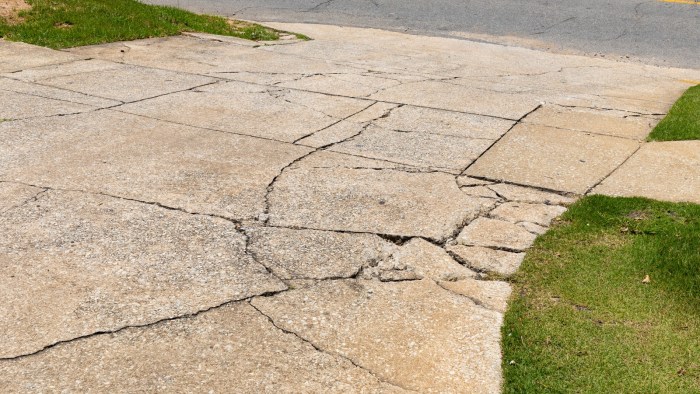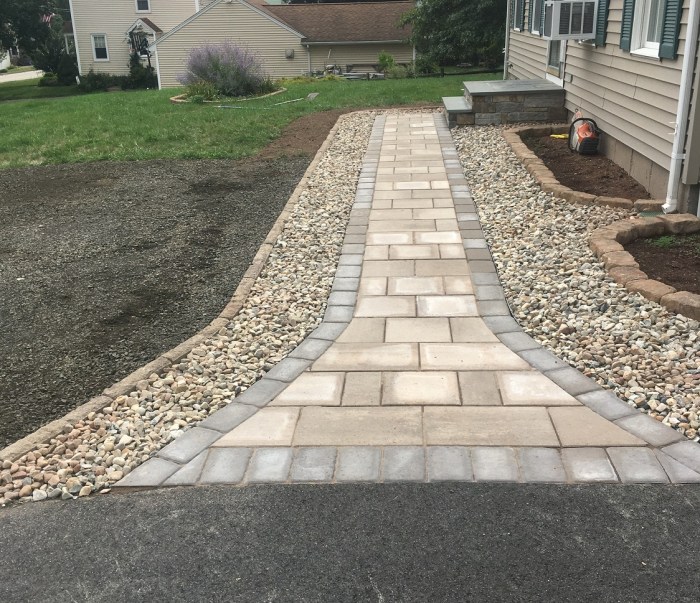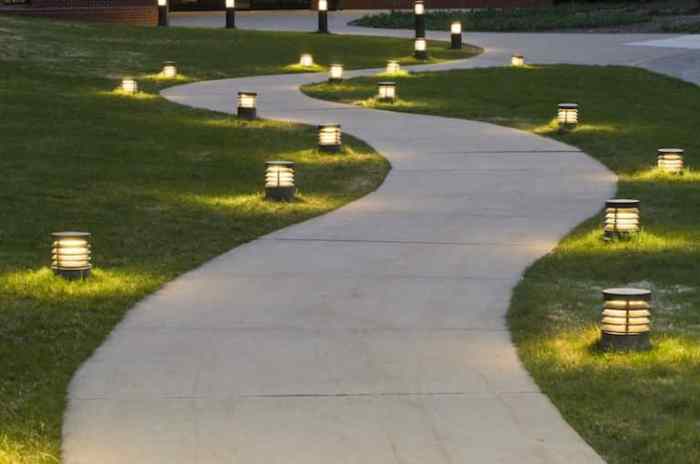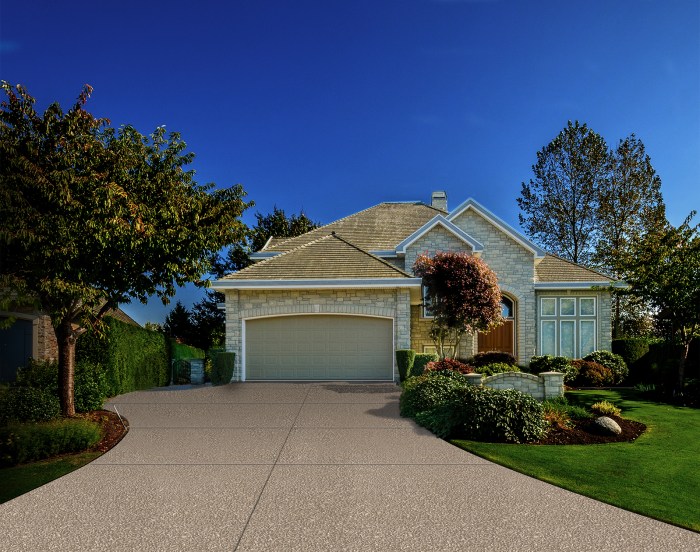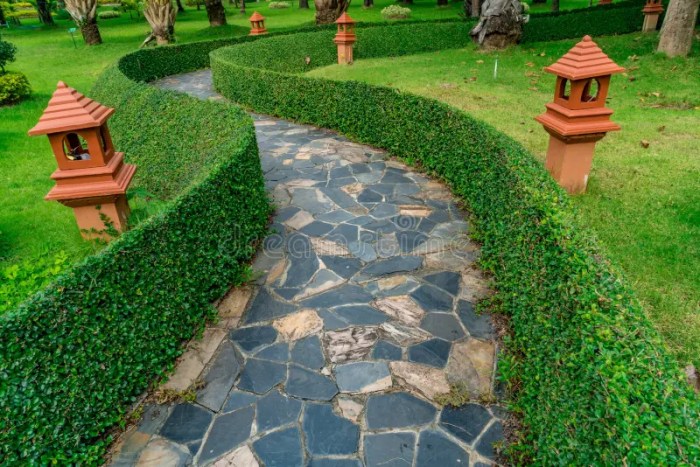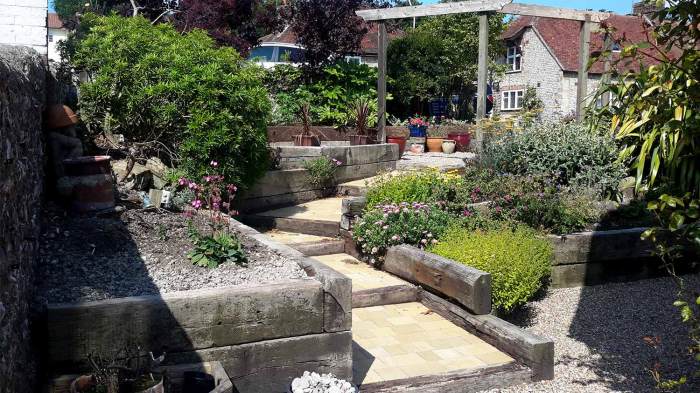Cement Pathways A Complete Guide
Cement pathways: They’re more than just walkways; they’re the unsung heroes of landscaping, quietly connecting different parts of our outdoor spaces. From sleek, modern designs to rustic, charming paths, cement offers a durable and versatile foundation for creating inviting outdoor areas. This guide dives into everything you need to know, from choosing the right cement type to maintaining your pathway for years to come. We’ll cover design, construction, maintenance, environmental considerations, and even aesthetic enhancements to help you create the perfect pathway for your needs.
We’ll explore the various types of cement available, comparing their durability, cost, and aesthetic appeal. You’ll learn how to plan and build your pathway, avoiding common pitfalls and ensuring a smooth, level finish. We’ll also discuss essential maintenance practices to keep your pathway looking its best and extend its lifespan. Finally, we’ll touch on the environmental impact of cement and how to make sustainable choices.
Types of Cement Pathways
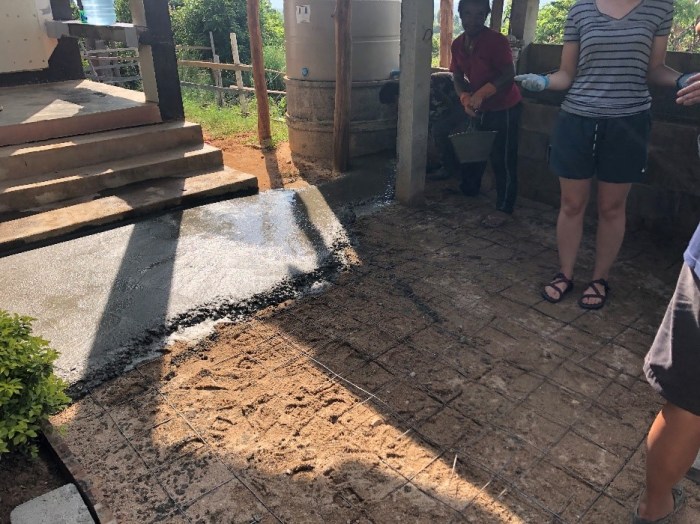
Source: wordpress.com
Choosing the right cement pathway involves considering several factors, including the desired aesthetic, durability, and budget. Different types of cement and construction methods offer a range of options to suit various needs and preferences. This section will explore the various types of cement pathways, comparing their characteristics and helping you make an informed decision.
Cement Types in Pathway Construction
While the term “cement” is often used loosely, it’s important to understand that Portland cement is the primary binding agent in most concrete pathways. However, variations in the mix design (the proportions of cement, aggregates, and water) significantly impact the final product’s properties. High-strength concrete, for example, uses a higher cement-to-aggregate ratio, resulting in increased durability but also higher cost. Using admixtures, like air-entraining agents (which improve freeze-thaw resistance), further modifies the concrete’s characteristics. The specific type of cement and mix design should be chosen based on local climate conditions and expected loads.
The Durability of Various Cement Pathway Designs
The durability of a cement pathway depends on several intertwined factors: the type of cement used, the quality of the construction (proper compaction, curing, and reinforcement), and the environmental conditions (freeze-thaw cycles, exposure to de-icing salts). A well-constructed pathway using high-strength concrete and proper reinforcement will generally last much longer than a poorly constructed one, regardless of the cement type. Stamped concrete, for instance, can be highly durable if properly sealed and maintained, resisting cracking and weathering better than a thinner, unreinforced poured concrete pathway. Precast concrete pavers, due to their nature, can be more resilient to localized damage, with individual units easily replaced if necessary.
Aesthetic Differences Between Pathway Types
Stamped concrete offers a wide range of design possibilities, mimicking the appearance of brick, stone, or even wood. The process involves stamping patterns into freshly poured concrete, creating a textured and visually interesting surface. Poured concrete, while simpler in appearance, can be colored, textured, or finished in various ways to achieve a desired look. Precast concrete pavers offer the most diverse aesthetic options, with a vast selection of shapes, colors, sizes, and textures available. From traditional brick-like patterns to more modern and abstract designs, precast pavers provide unparalleled flexibility in creating unique pathway aesthetics.
Cost-Effectiveness of Different Cement Pathway Materials, Cement pathways
The cost of a cement pathway is influenced by several factors including materials, labor, and design complexity. Stamped concrete, due to the additional labor involved in stamping and finishing, tends to be more expensive than plain poured concrete. Precast concrete pavers can vary widely in price depending on the material, style, and source. Generally, plain poured concrete represents the most cost-effective option, while highly customized stamped or precast designs can be significantly more expensive.
| Pathway Type | Material Cost | Labor Cost | Total Estimated Cost (per sq ft) |
|---|---|---|---|
| Plain Poured Concrete | Low | Low | Low |
| Stamped Concrete | Medium | High | Medium-High |
| Precast Concrete Pavers | Medium-High | Medium | Medium-High |
Design and Construction of Cement Pathways
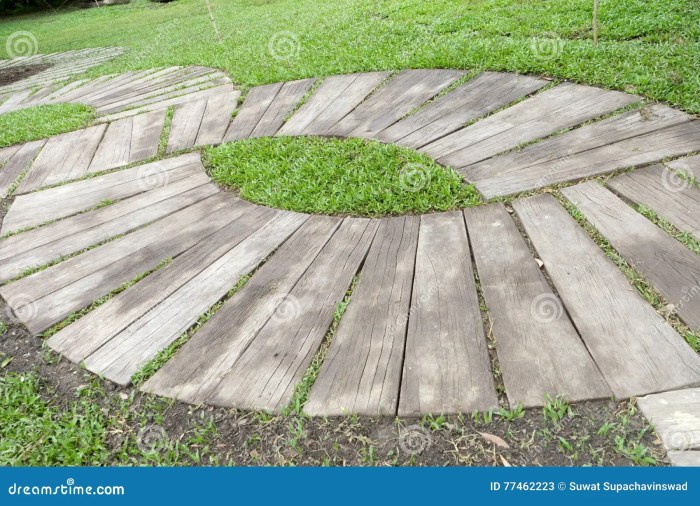
Source: dreamstime.com
Planning and building a cement pathway might seem daunting, but with a little preparation and the right approach, you can create a beautiful and durable addition to your landscape. This section Illustrates the design process and provides a step-by-step guide for construction, ensuring a smooth, long-lasting result.
Pathway Design Planning
Effective pathway design begins with careful planning. Consider the pathway’s purpose – will it be primarily for foot traffic, or will it need to accommodate wheelbarrows or other small vehicles? Measure the area accurately and sketch a preliminary design, noting any existing features like trees, flowerbeds, or structures that need to be incorporated or avoided. Think about the pathway’s width; a narrow path is suitable for pedestrian traffic, while a wider path might be needed for wheelchair access or multiple people walking side-by-side. Choose a suitable location that maximizes sunlight exposure to help the concrete cure properly and minimize potential water pooling. Finally, select a design that complements your home’s architectural style and landscaping.
Step-by-Step Cement Pathway Construction
- Excavation and Base Preparation: Dig a trench to the desired depth (usually 4-6 inches) and width of your pathway. Ensure the base is level using a spirit level. Compacting the soil base thoroughly is crucial for preventing settling and cracking. Adding a layer of gravel (about 2 inches) provides excellent drainage and further strengthens the base. Compact the gravel layer as well.
- Formwork Construction: Construct the forms (wooden boards or metal edging) around the perimeter of the pathway to contain the concrete. Ensure the forms are level and securely braced to prevent movement during pouring. For curves, use flexible forms or create them from multiple smaller sections.
- Concrete Mixing and Pouring: Mix the concrete according to the manufacturer’s instructions. Use a wheelbarrow or a concrete mixer for larger projects. Pour the concrete into the forms, ensuring even distribution. Work in sections to maintain a consistent pour and avoid uneven settling.
- Leveling and Finishing: Use a screed (a long, straight board) to level the concrete surface. Work the concrete with a bull float to remove air bubbles and create a smooth surface. For a textured finish, use a broom to create grooves. Allow the concrete to set for the recommended time before removing the forms.
- Curing: Proper curing is vital for the concrete’s strength and durability. Keep the concrete moist for several days by covering it with plastic sheeting or burlap sacks. This prevents the concrete from drying out too quickly, which can lead to cracking.
Ensuring a Smooth, Level Pathway Surface
Achieving a smooth, level surface requires attention to detail at each stage. Accurate excavation and careful compaction of the base are paramount. Using a level and screed during the pouring and leveling process is essential. Properly vibrating the concrete helps eliminate air pockets and ensure a uniform consistency. Finally, using a bull float and finishing tools creates a smooth, even surface. Remember that even small imperfections can lead to tripping hazards or uneven wear over time.
Common Challenges and Solutions
- Cracking: Cracking can result from insufficient base preparation, poor concrete mix, rapid drying, or temperature fluctuations. Solutions include proper base compaction, using a quality concrete mix, and proper curing techniques.
- Uneven Surface: Uneven surfaces are usually caused by inadequate leveling during pouring or settling of the base. Solutions include careful leveling during the pouring process, ensuring proper base compaction, and using a spirit level throughout the process.
- Spalling (Chipping): Spalling can be caused by poor-quality concrete or freeze-thaw cycles. Using a high-quality concrete mix and proper curing can mitigate this problem. Adding admixtures that enhance freeze-thaw resistance is another effective solution.
Maintenance and Repair of Cement Pathways
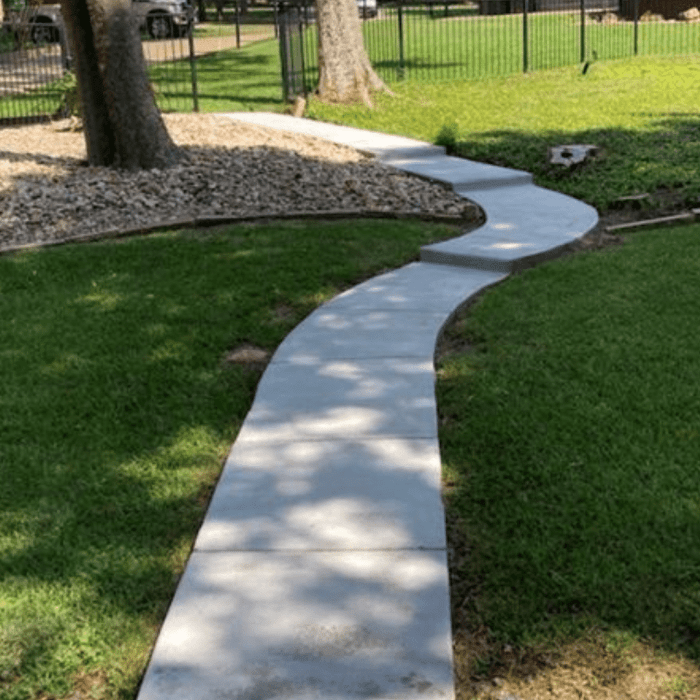
Source: samtheconcreteman.com
Keeping your cement pathway in top condition involves a blend of proactive maintenance and timely repairs. Regular care prevents significant problems down the line, saving you time, money, and frustration. Neglect, however, can lead to costly and extensive repairs. This section details how to maintain and repair your pathway effectively.
Regular Maintenance Tasks
Regular sweeping or blowing away leaves, dirt, and debris prevents accumulation that can trap moisture, leading to cracking and weed growth. Power washing (using a low-pressure setting to avoid damage) can remove stubborn stains and grime. Sealing the pathway every few years, depending on climate and usage, protects it from the elements and prevents water penetration, a major cause of deterioration. Regular inspection for cracks, discoloration, or settling is crucial for early detection and timely intervention. Addressing minor issues promptly prevents them from escalating into larger, more expensive problems.
Repairing Cracks in Cement Pathways
Cracks, a common issue in cement pathways, can range from hairline fractures to larger fissures. Small cracks can often be repaired using a crack filler specifically designed for concrete. The crack should be cleaned thoroughly, ensuring it’s free of dust and debris. The filler is then applied, ensuring it’s pressed firmly into the crack and leveled with the surrounding surface. Larger cracks may require more extensive repair, potentially involving removing the damaged section and patching it with a concrete mix. This involves creating a clean, straight edge around the damaged area before applying fresh concrete and ensuring proper curing time. For cracks exceeding a half-inch in width, consider consulting a professional contractor.
Addressing Signs of Deterioration
Signs of deterioration in cement pathways include cracking (as discussed above), spalling (chipping or flaking of the concrete surface), discoloration (often indicating water damage or chemical reactions), and settling (uneven surfaces indicating foundation issues). Spalling is usually addressed by removing the damaged sections and patching them with fresh concrete. Discoloration often requires cleaning and potentially resealing. Settling may necessitate more extensive work, potentially involving adjusting the base or foundation of the pathway. Early identification of these issues is key to effective and cost-effective repairs.
Tools and Materials for Cement Pathway Repairs
A basic toolkit for cement pathway repairs should include: a stiff-bristled broom, a shovel, a putty knife, a wheelbarrow, a concrete mixer (or a bucket for smaller jobs), a trowel, a rubber mallet, safety glasses, work gloves, and a measuring tape. Necessary materials vary depending on the type and extent of the damage but commonly include concrete patching compound, crack filler, sealant, and possibly fresh concrete mix (cement, sand, and gravel). Remember to always check the manufacturer’s instructions for proper mixing ratios and application methods.
Environmental Considerations
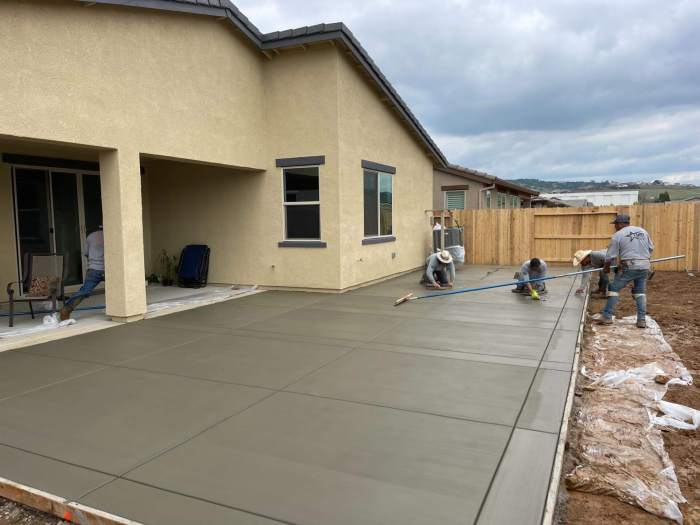
Source: caproconcrete.com
Creating cement pathways, while offering practical benefits, carries environmental consequences. The production and use of cement contribute significantly to greenhouse gas emissions and resource depletion. However, through careful planning and the adoption of sustainable practices, we can minimize these impacts and create more environmentally friendly pathways.
Cement production is an energy-intensive process, releasing substantial amounts of carbon dioxide (CO2) into the atmosphere. The manufacturing process itself, along with the transportation of materials and the eventual demolition of the pathway (if applicable), all add to its overall carbon footprint. The extraction of raw materials, such as limestone and clay, also contributes to land disturbance and habitat fragmentation.
Sustainable Practices in Cement Pathway Construction
Sustainable pathway construction prioritizes minimizing environmental impact throughout the project lifecycle. This involves careful material selection, efficient construction techniques, and responsible disposal or recycling practices.
- Using recycled materials: Incorporating recycled aggregates (like crushed concrete or recycled asphalt) in the cement mix reduces the demand for virgin materials and lowers the overall embodied carbon.
- Selecting low-carbon cement: Portland cement alternatives, such as geopolymer cement or blended cement with fly ash or slag, produce significantly less CO2 during production. Fly ash, a byproduct of coal combustion, and slag, a byproduct of steel production, can partially replace Portland cement, reducing its overall environmental impact.
- Optimizing cement mix design: Precisely calculating the required cement quantity for the pathway ensures that no excess material is used, minimizing waste and reducing the overall carbon footprint.
- Reducing transportation distances: Sourcing materials locally minimizes fuel consumption and associated emissions during transportation.
- Implementing erosion and runoff control: Proper drainage systems and vegetation around the pathway help prevent soil erosion and reduce water pollution from construction activities.
Comparison of Different Cement Types
Different types of cement have varying environmental impacts. Portland cement, the most common type, has a high carbon footprint due to its high energy requirements during production. Conversely, supplementary cementitious materials (SCMs) like fly ash and slag, when used in blended significantly reduce CO2 emissions. Geopolymer cement, a completely different type of cement made from industrial byproducts, offers an even lower carbon footprint compared to traditional Portland cement. A pathway constructed using a geopolymer cement mix would have a considerably smaller environmental impact than one made using standard Portland cement. However, factors such as availability, cost, and performance characteristics need to be considered when choosing a specific cement type.
Environmentally Friendly Pathway Design
A pathway designed with environmental considerations in mind would prioritize sustainable materials and construction techniques. For example, a pathway could incorporate permeable paving materials allowing rainwater to seep into the ground, reducing runoff and replenishing groundwater. The use of locally sourced, recycled aggregates in the concrete mix would minimize transportation emissions and reduce reliance on virgin materials. Incorporating native plants along the pathway edges could provide habitat for local wildlife and reduce the need for water-intensive landscaping. The entire design should aim to minimize disruption to the surrounding environment, potentially using existing land features to reduce the need for extensive excavation. For instance, instead of a straight path, a winding path that follows the natural contours of the land would minimize land disturbance.
Aesthetic Aspects of Cement Pathways
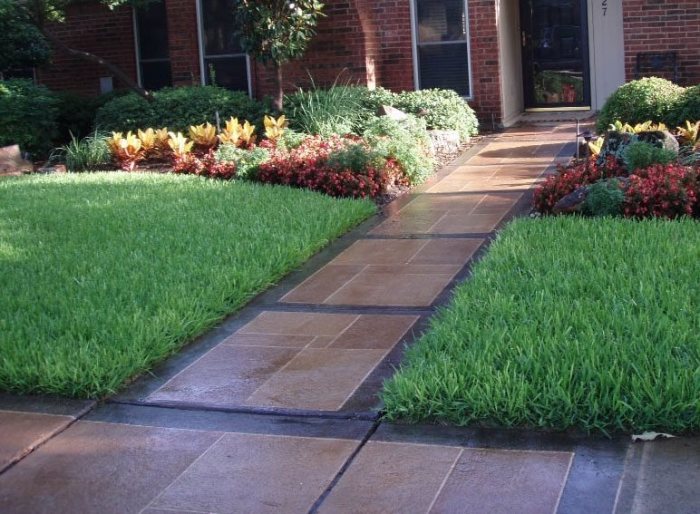
Source: landscapingnetwork.com
Creating visually appealing cement pathways goes beyond just functionality; it’s about enhancing the overall aesthetic of your outdoor space. By thoughtfully considering design elements, you can transform a simple walkway into a stunning feature that complements your home and garden. The right design can even increase your property value!
Design Elements for Visually Appealing Pathways
Several design elements can significantly impact the visual appeal of a cement pathway. These include the choice of color, the incorporation of patterns and textures, and the strategic use of lighting. Careful consideration of these factors will ensure your pathway is both practical and beautiful.
Examples of Creative Pathway Designs
Many creative pathway designs exist, each offering a unique aesthetic. For instance, a simple yet elegant design might involve a meandering pathway with subtly varying shades of gray concrete, creating a sense of depth and movement. More elaborate designs could incorporate intricate patterns, such as mosaics or stamped concrete designs mimicking natural stone or brick. The use of contrasting colors, like dark gray and light beige, can also add visual interest. Textured surfaces, achieved through the use of specialized tools or aggregates during the pouring process, can further enhance the pathway’s visual appeal, offering a tactile dimension beyond just the visual.
Lighting to Highlight Pathway Features
Strategic lighting can dramatically enhance the beauty of a cement pathway, especially at night. Recessed lighting along the pathway’s edges provides gentle illumination, guiding the way while subtly highlighting the pathway’s texture and color. Uplighting strategically placed along the pathway can create a dramatic effect, casting interesting shadows and highlighting any decorative elements. Path lights with varying intensities can also be used to create a dynamic and inviting atmosphere. Consider using warm-toned lighting to create a cozy and welcoming ambiance.
Visual Representation of a Unique Pathway Design
Imagine a gently curving pathway leading through a lush garden. The pathway itself is composed of a light beige concrete, subtly textured to resemble weathered stone. Inlaid within the concrete are irregularly shaped pieces of dark gray slate, creating a natural, almost mosaic-like effect. These slate pieces are not uniformly distributed, instead forming a meandering pattern that echoes the curve of the pathway itself. Low-voltage path lights, emitting a warm, amber glow, are discreetly placed along the pathway’s edges, casting a soft light that highlights the texture of the concrete and the darker slate accents. The overall effect is one of understated elegance and natural beauty, seamlessly integrating the pathway into the surrounding landscape.
Accessibility and Safety
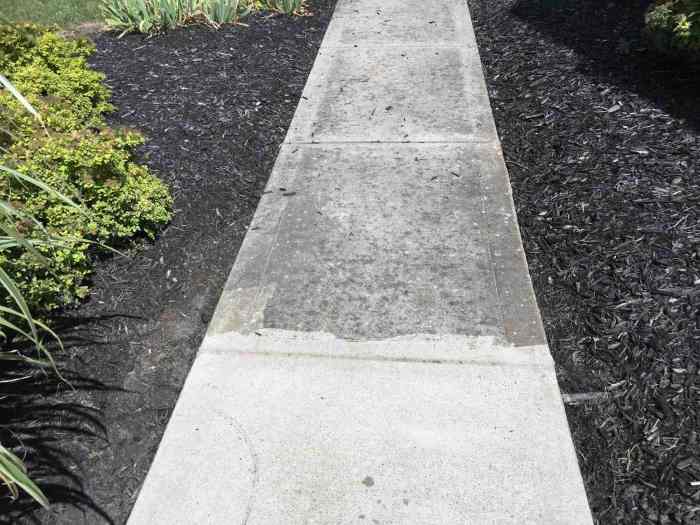
Source: storables.com
Creating safe and accessible cement pathways is crucial for ensuring everyone can comfortably and confidently use them. Poorly designed pathways can present significant barriers for people with disabilities and pose safety risks for all users. This section will explore key design features that enhance accessibility and safety, highlighting potential hazards and providing examples of inclusive design.
Importance of Accessibility in Cement Pathway Design
Accessible pathways are vital for fostering inclusivity and ensuring equal access for all members of the community, regardless of age, ability, or mobility. Universal design principles should guide the creation of pathways that are usable by everyone, without the need for special adaptations or assistance. This includes consideration for people using wheelchairs, walkers, strollers, or those with visual or cognitive impairments. Failing to prioritize accessibility excludes a significant portion of the population and limits their ability to participate fully in community life.
Design Features Enhancing Pedestrian Safety
Several design features significantly improve the safety of cement pathways. Proper lighting, for example, is crucial for nighttime visibility, reducing the risk of trips and falls. A smooth, even surface, free from cracks, significant changes in elevation, and tripping hazards, is paramount. Adequate width, allowing for comfortable passage of multiple pedestrians, including those using mobility aids, is also essential. CleMarkedges, perhaps using contrasting colors or textures, helps visually impaired individuals navigate safely. Incorporating ramps with gentle slopes at intersections eliminates barriers for wheelchair users and strollers.
Potential Hazards of Poorly Designed or Maintained Pathways
Poorly designed or maintained cement pathways pose several safety hazards. Cracks and uneven surfaces can cause trips and falls, leading to injuries ranging from minor scrapes to serious fractures. Insufficient lighting increases the risk of accidents at night. Poor drainage can lead to slippery surfaces, especially after rain, increasing the risk of slips and falls. The absence of handrails on ramps or inclines can make navigation difficult and dangerous for people with mobility impairments. Lack of clear signage or wayfinding can disorient users and increase the risk of getting lost or injured. Overgrown vegetation or obstructions along the pathway can also create tripping hazards and reduce visibility.
Examples of Inclusive Design Features
Inclusive design considers the needs of all users. Examples include tactile paving, which provides sensory cues for visually impaired pedestrians; ramps with gentle slopes and handrails for wheelchair users and those with mobility challenges; sufficient pathway width to accommodate wheelchairs and other mobility aids; marked crossings and intersections; adequate lighting for visibility at all times; and the use of contrasting colors or textures to delineate pathway edges and changes in elevation. Consideration should also be given to providing seating areas along longer pathways for rest and respite. A well-designed pathway might also incorporate textured surfaces to improve traction in wet conditions.
Closing Notes
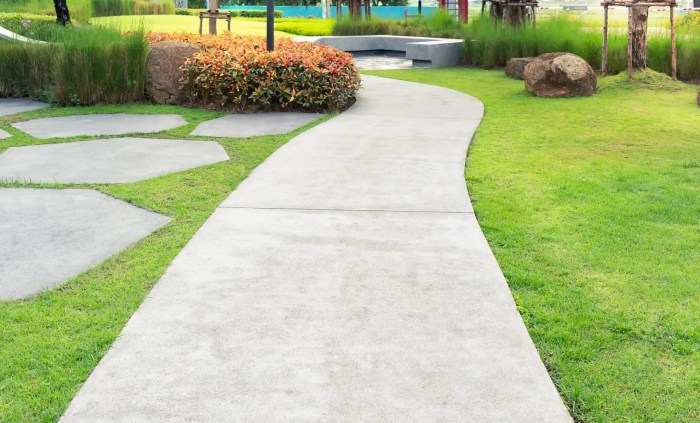
Source: worcesterconcrete.com
Creating the perfect cement pathway is a blend of planning, execution, and ongoing care. By understanding the different types of cement, employing proper construction techniques, and implementing regular maintenance, you can enjoy a beautiful and functional pathway for years to come. Remember to prioritize accessibility and safety in your design, and don’t be afraid to get creative with textures, colors, and lighting to truly personalize your outdoor space. With the right knowledge and a bit of effort, your cement pathway can become a stunning focal point of your property.
